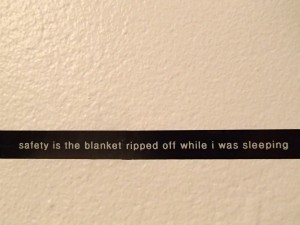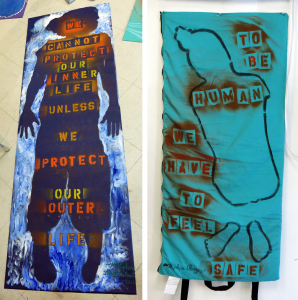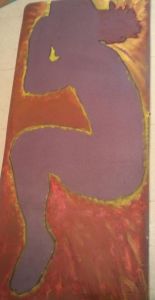When it comes to trauma, the body pulls rank. I can use willpower to wish away symptoms and ask my brain to try to outsmart fear – but to make myself feel safe – I actually have to feel safe.
This is tricky because I have a PhD. in terror and lifelong experience with living while afraid. Jumping up into my head or the space right above it has been my go-to coping technique. Coming back down and into the body has been quite an adjustment. It’s also been the only gateway “drug” to inhabiting my body, knowing true healing and recovery are possible and to feeling joy. Through trial and error I’ve learned how yoga, music, breathing, guided imagery and free-writing help me feel less freaked while afraid.
I learned none of this from the work of Stephen Porges, Ph.D., who I watched speak with Ruth M. Buczynski, Ph.D. last week on a free webinar. However, I did better understand my own bodily post-traumatic stress responses and that’s been amazing.

Yoga mats altered for installation at Mobius. Porges work, on right, “to be human we have to feel safe” – outline of disembodied feeling child.
Key points:
-
Being impacted by trauma isn’t a choice. Fear induces bodily responses which may not appear wise or logical but which are safety-driven.
-
Responses to trauma aren’t simply fight or flight as is often said but also include freeze responses.
-
Survival is necessary for living. Safety is necessary for living well with others.
We humanoids have unconscious reactions to terror that may feel entirely unique to us but which aren’t all that strange or mysterious.
This knowing reminds me that feelings and symptoms aren’t moral or personal failures – just simple facts of life – and proof of having a body.
When my body temperature rises because of a fever I don’t chastise myself for my inability to stay cool. Fevers aren’t fun but one doesn’t choose them. Same with fear.
Trauma survivors are often judged, criticized and shamed for being injured by trauma – seemingly more than perpetrators of violence are for being violent – so knowing how deep, primal and unconscious fear responses are is validating. Understanding how and why my body reacted the way it did to traumatic stress helps me breathe out more deeply and in that space hope can move it and shame move out. Thank you Stephen Porges.
II’ve been thinking about Polyvagal Theory since last May when I heard Porges speak at the Trauma Conference in Boston. My friend Margaret Bellafiore and I materialized some of his concepts in an interactive trauma installation at Mobius.org). He understands and explains the problem trauma survivors have with trust. He gets fancy but basically a trauma survivor lives/feels and thinks:
People hurt me. Who needs people? It’s sort of that simple. And it makes sense.
Or, to quote him:
“If they (trauma survivor) got injured they will get tuned to not let anyone on board.”
“People who have been really hurt find it difficult to create relationships even though on a cognitive level it’s a high priority. Body is saying ‘no.’ I try to explain to individual what their body has done has saved their lives. It’s adaptive.”
 Ding. Dong. Bingo. Yup.
Ding. Dong. Bingo. Yup.
People have talked for decades about replacing old survival skills with more adaptive ones but in a way that made it sound as though a trauma survivor is a dope stuck on the stupid race track when there’s an exit ramp so close. In fact, a body – as in any body – experiencing terror will be – wait – terrified.
Which isn’t just a word or thought or concept but a bodily sensation. I’m dumbing down what Porges studies but basically, the body does what the body does, and there’s lots of science stuff which explains why (to do with the vagus, cranial nerves and how it all connects in heart and brain and bodily functions).
From my perspective – it feels like this – it’s not all that personal.
I don’t get pissed off at other people who get sea sick on a whale watch for their failure not to hurl. Similarly, I can remember that I didn’t choose my fear reactions either.
This is kind of huge.
Fear expressed itself through my body and continues to live and “get vocal” inside of me when I’m triggered or stressed. And while it’s a fact I don’t love – having lingering residue thanks to trauma – it’s not a moral failing or cuz-I’m-lazy personality flaw. Simply put: It”s my body doing what my body does when I’m afraid. Period.
The simplicity of this wider and bigger perspective is pretty profound. It used to feel (and sometimes still feels) as though safety is a secret room inside everyone else lives in but me. Like it should be a place I should be able to get to easily when often it feels like another country far away and outside of me, one I’ve never visited, don’t have a passport to, won’t know the language and culture but very much am desperate to arrive in anyhow.
I was embarrassed that my navigation skills were so clumsy and tried to avoid situations where my lack of skill would be obvious. You know, stay in the neighborhood, don’t go too fast or drive at night. It’s safe but it’s not terribly exciting either.
Intimacy requires pushing outside of the regular terrain and entering the geography of another.
Damn. It still feels awkward to trust, love, be vulnerable (really raw) or ask for help – you know – from people – especially when animals, plants, blankets books and movies are so much more predictable. This is a hard coping skill to mold. However, I’m less pissed at myself and get it more.

Photo Credit: Margaret Bellafiore
How about believing that anyone terrified, tortured, neglected or abandoned might react similarly to being human? Maybe I’m rather fabulous and resilient – ya know – for being alive.
Porges encourages trauma survivors to rewrite the personal narratives. And honestly, words like ‘rewrite personal narrative’ are word crack to junkie writers. It’s doable, understandable and something I can wrap my heart and mind around.
When people get sea sick I feel sad they aren’t enjoying the whale. Not once do I think they are damaged losers choosing to puke when they could simply appreciate nature’s beauty instead. My fear responses are just bodily responses not me sucking at my life.
It’s not that this knowing means I never shut down, get numb, get busy or find the door when I’m scared. Sometimes I do all of those things while diving into a bag of Tostitos. However, I shame myself less and focus on getting back to safety, feeling safe, as quickly as possible.
I used to spend ALL OF MY TIME trying to master living well while terrified and now PUT MUCH MORE ENERGY into creating safety which transforms my life. This might seem obvious to others but was a simple exercise and point I missed for about two decades.
 Instead of being a lifelong archeologist collecting the bones of my painful past I can accept the pile at my feet. It’s not a passive acceptance but compost for self-compassion. Without fighting or running as often my attention turns to the now where I can learn the names of the lush green plants in the here and now – hope, promise, bonding, resilience, love and possibility and strengthen my relationship with myself as well as with others – which always bears fruit and beauty.
Instead of being a lifelong archeologist collecting the bones of my painful past I can accept the pile at my feet. It’s not a passive acceptance but compost for self-compassion. Without fighting or running as often my attention turns to the now where I can learn the names of the lush green plants in the here and now – hope, promise, bonding, resilience, love and possibility and strengthen my relationship with myself as well as with others – which always bears fruit and beauty.
It’s not that I’m too afraid to face the past or feel it to heal it to deal (and how many of us did that for a decade before that concept was even road tested?) – been there – done that. No. Instead of being an expert in trauma I attempt to get expert at inhabiting my body, providing safety for myself and this turns out to be far more fun and less expensive than talk therapy.
It’s like I’m aging backwards and becoming a toddler at midlife discovering the color, textures, sights, sounds, emotions and nuances.
I’m realizing the truth of another thing Porges said – SAFETY IS THE TREATMENT.
Any time I feel safe, joyful, loved, loving, attached, connected, mindful and compassionate – I’m doing THE MOST IMPORTANT healing work possible.
I’m still guilty of riding the brakes and not just in my car. Often, I stay too cautious or at the edge, watching. And equally as often, I bolt for the door when it might be wiser to stay still and dive deeper. The difference is that now I notice I want or feel the urge to run and can sit still with the impulse and the fear rather than moving to another place. I know that if I let fear take the wheel it will drive me down the same old roads. If I need familiar I may wish to visit those places. And sometimes I do. But I don’t stay. They never gave me what I was searching for. Never. To get some place new and different – I will need my GPS, courage and a willingness to arrive in a new place as a passenger driven by something more skilled than fear.

Friendship. Nature. Yoga buddies sharing a meal and a night by the beach. This is where the healing happens.
It’s scary to be human. It’s hard to be invested and emotional, attached and intertwined. However, it’s far more terrifying to live in constant fear, defended and isolated and only worried about not getting hurt.
Playing it safe is not the same thing as being truly safe and that’s what I’m finally learning. And these nuances can take a life to learn. Luckily, the work is endlessly enriching and rewarding.
In the next few days I’ll write about “neuroception” – a term coined by Porges – as well as some of the other break-the-cycle living and parenting concepts he discussed.
Further Reading:
- Previous interview transcribed covering similar though not identical content.
- Porges website.
- Memoir essay I wrote after first hearing the work of Porges.
You Matter Mantras
- Trauma sucks. You don't.
- Write to express not to impress.
- It's not trauma informed if it's not informed by trauma survivors.
- Breathing isn't optional.
You Are Invited Too & To:
- Heal Write Now on Facebook
- Parenting with ACEs at the ACEsConectionNetwork
- The #FacesOfPTSD campaign.
- When I'm not post-traumatically pissed or stressed I try to Twitter, Instagram & Pinterest.
What a wonderful response to Stephen Porges and his polyvagus work! Wonder what you’ll do with the remaining five webinars. Hats off.
I read through some of Dr. Porges work and watched some videos but it’s not quite registering. I’ll keep at it though because I’ve watched another seminar on Compassion Fatigue that talks about the vagus nerve and that did make sense.
What I really loved is hearing “Safety is the treatment.” The concept that as survivors, we live our lives ‘faking normal’ or white knuckling through life is finally becoming cruel enough to me, that I’ve just started giving myself permission to accommodate my own needs. Isn’t that nuts? Wild? Radical? Yes. And it’s also been really kind, compassionate, humanistic and peaceful.
I buy the soft blanket, and the shirt that is beautiful and covers my body how I want it to be covered. I eat the good food, even if it costs more. I create the space I want to come home to and set the pace for how I want to live. I set the boundary and leave when I need, instead of stay to make ‘them’ happy. I say ‘no’. I practice not apologizing. The hardest part is communicating those complex needs to a loving and available partner. You keep waiting for the other person to get sick of all your disclaimers, but the price my body makes me pay for not honoring those disclaimers has become too high. And then there’s the balancing of awareness. I think at some point I began looking around at people and noticing they had all managed to figure out what they wanted or needed to have a nice day at the beach or a good hike; were my ‘disclaimers’ or needs really any different? or any more or less? No. I had just deemed all of my needs as excessive, obnoxious, too much-insert the sound of my mother sighing, my father screaming or someone rolling their eyes. Permission to be alive and have needs-granted. Meeting needs = Safety = not aggravating that polyvagus nerve and spending the day with acute anxiety because of out of control somatic symptoms.
The most basic question gets missed by healthcare: What do you need to feel safe before we begin? Imagine if a doctor asked that?? Most don’t, so I’ve had to learn to be my own advocate, which can be exhausting. Hooray for trauma-informed care!
Anyway, great stuff. Thank you!
Hi Elizabeth,
Some of the material can be a little dry. I try to distill it to useful gems – at least for myself 🙂 and SAFETY is the TREATMENT is wonderful isn’t it? It’s so basic but so profound.
It takes practice doing the self-care or just basic care that others learn. But it’s exactly what you describe. We can do it but it’s not always the first impulse. So glad you came by! Cissy